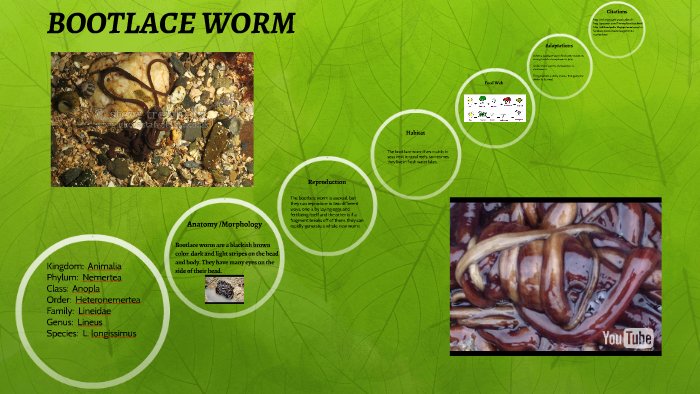
Understanding Bootlace Worms’ Diet
Bootlace worms are primarily carnivorous, with a diet that mainly consists of small marine animals. They feast on creatures like **crustaceans, mollusks**, and **dead marine matter**. The worms have a unique way of feeding: they use their specialized body parts to absorb nutrients from their prey rather than eating it in the traditional sense. Imagine a sponge soaking up water—this is similar to how bootlace worms draw in nutrients.
Their diet varies based on availability, which means they adapt their feeding habits according to what’s around. In areas with abundant food sources, they might eat more frequently. But if the pickings are slim, they can sustain themselves for longer periods without a meal. Just like we sometimes binge on snacks when they’re plentiful but can skip meals when we’re busy, bootlace worms adjust based on circumstance.
Key Food Sources
Here’s a closer look at what bootlace worms enjoy eating:
- Crustaceans: These are tiny animals like shrimp and crabs that provide essential proteins.
- Mollusks: Soft-bodied animals such as clams and snails offer a rich nutrient source.
- Marine Detritus: The decaying remains of other organisms give bootlace worms a reliable energy source.
Feeding Frequency of Bootlace Worms
So, how often do bootlace worms eat? Well, there’s no simple answer. Their feeding frequency can be quite variable, influenced by several factors including the availability of food, environmental conditions, and their life stage. Generally speaking, these worms don’t follow a strict meal schedule.
In a nutrient-rich environment, bootlace worms may feed multiple times a week. Conversely, if food is scarce, they can go for days, even weeks, without eating. This adaptability is crucial for survival in the wild. Think of it like this: if you’re at a buffet with endless options, you’re more likely to eat frequently. But if you’re at a picnic with just a few snacks, you’ll pace yourself.
Factors Influencing Feeding Patterns
Several factors can influence how often bootlace worms feed:
- Food Availability: More food means more frequent feeding.
- Water Temperature: Warmer waters can boost metabolism, increasing feeding frequency.
- Life Stage: Juvenile worms may require more nutrients to grow, leading to more frequent meals.
Energy Needs of Bootlace Worms
Just like any living creature, bootlace worms have specific energy requirements to thrive. These needs can vary based on their size, age, and activity levels. The energy they derive from their meals fuels their growth, movement, and overall health.
If you think about how you feel after a hearty meal versus a light snack, that’s similar to how bootlace worms operate. A well-fed worm is likely more active and healthier, while a hungry one may be less lively and struggle to thrive.
How Energy Is Utilized
Bootlace worms use the energy they gain from food for several key functions:
- Movement: They need energy to navigate their underwater environments and search for food.
- Growth: More energy translates to better growth rates, especially for younger worms.
- Reproduction: Producing offspring requires significant energy, making feeding vital during breeding seasons.
Adaptations for Energy Conservation
Bootlace worms have some fascinating adaptations that help them conserve energy. In times of food scarcity, they can enter a state of dormancy. This allows them to slow down their biological processes and extend their survival during tough times. It’s kind of like when you skip a meal here and there without feeling faint—you adapt to make it through.
They also have a low metabolic rate, which means they don’t burn energy as quickly as some other marine animals. This is an advantage in environments where food isn’t always abundant. So, while they might not be the fastest eaters, they sure know how to make the most out of what they consume.
Energy Conservation Strategies
Here’s how bootlace worms conserve energy:
- Dormancy: Reducing activity to save energy during food shortages.
- Efficient Digestion: Maximizing nutrient absorption to get the most out of each meal.
- Low Metabolism: Slowing down body processes to extend energy reserves.
The Role of Environment on Feeding and Energy
The environment plays a crucial role in how bootlace worms feed and manage their energy needs. Factors like water quality, temperature, and availability of food sources can significantly impact their lifestyle.
For example, in colder waters, the metabolic rate of bootlace worms tends to decrease. As a result, they may eat less often and require fewer nutrients to maintain their health. These adaptations help them survive in harsh conditions where food scarcity is common.
Impact of Environmental Factors
Here are some key environmental factors that affect bootlace worm feeding and energy needs:
- Water Temperature: Warmer temperatures boost metabolism, leading to more frequent feeding.
- Oxygen Levels: Higher oxygen levels can improve activity and energy levels, motivating them to feed.
- Food Availability: A rich ecosystem supports more frequent feeding opportunities.
Understanding the feeding frequency and energy needs of bootlace worms is essential to appreciating how these unique creatures survive in their underwater homes. Their ability to adapt to changing food sources and manage energy levels helps them thrive in various conditions, making them one of nature’s marvels.
Next time you think about marine life, consider these clever worms and how they manage their resources. Just like us, they have to navigate challenges in their environments to stay healthy and fed. The more we learn about creatures like bootlace worms, the more we can appreciate the complexity of marine ecosystems. Whether you’re an aspiring marine biologist or just a curious reader, there’s always something new to uncover in the world beneath the waves!
